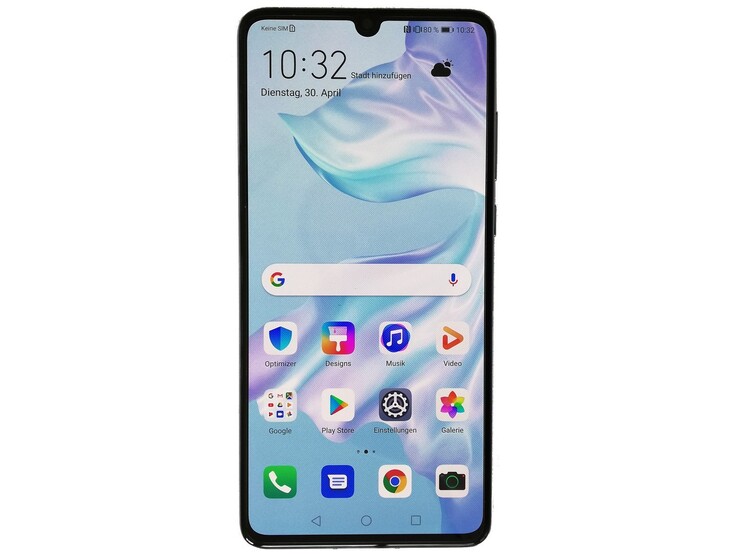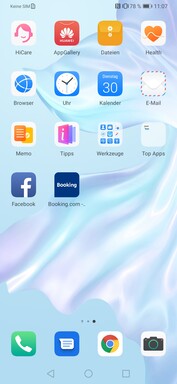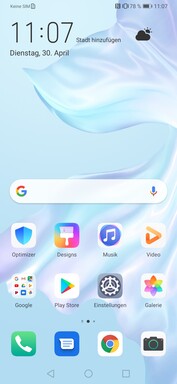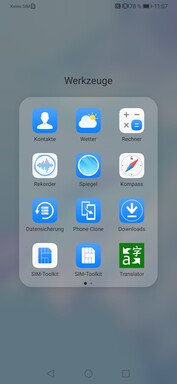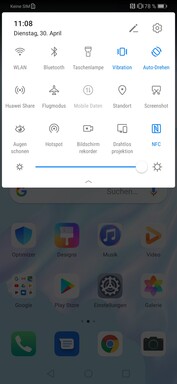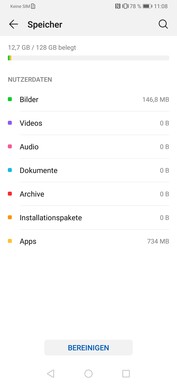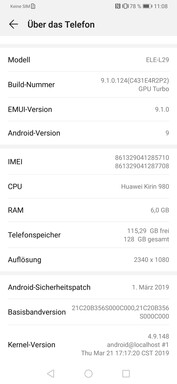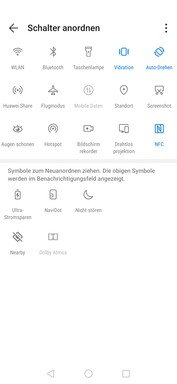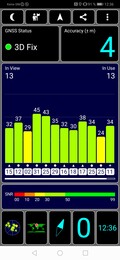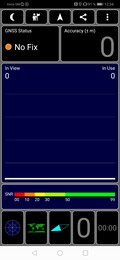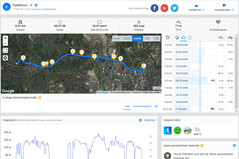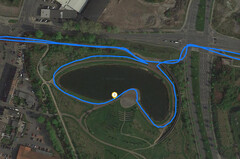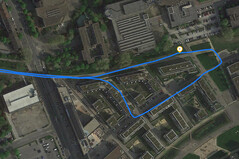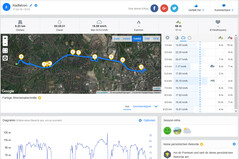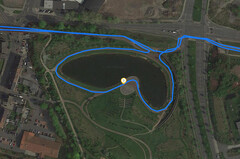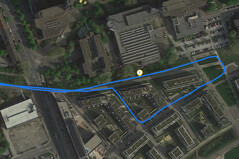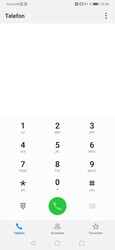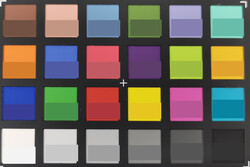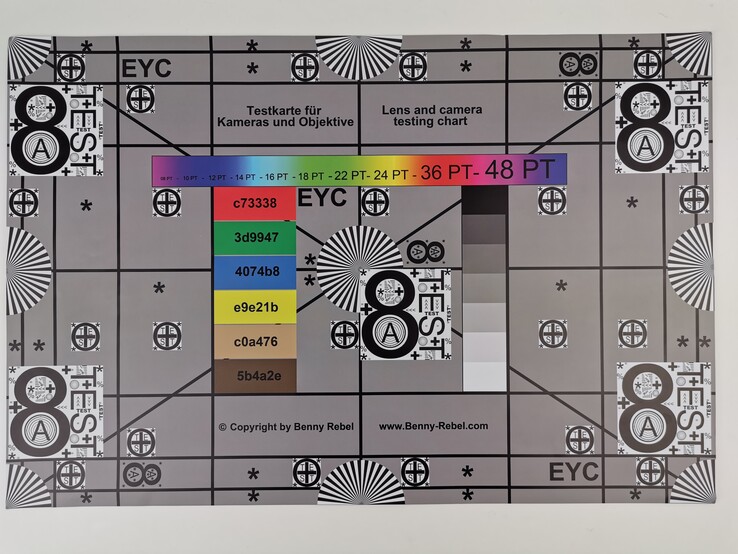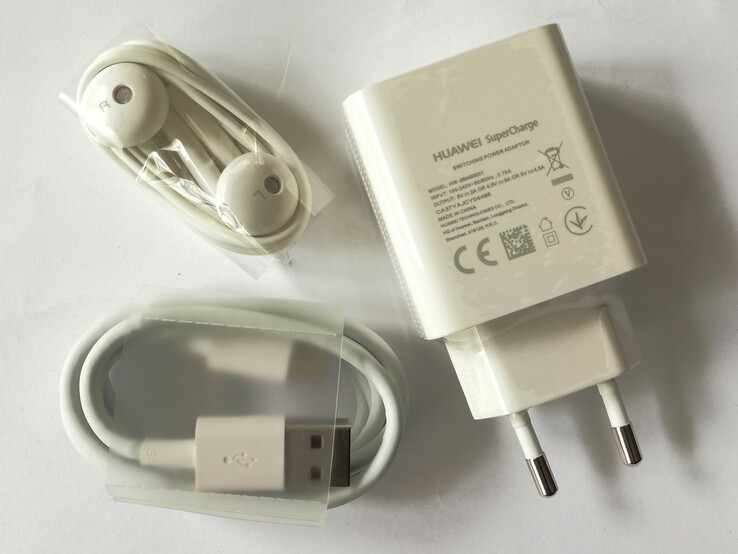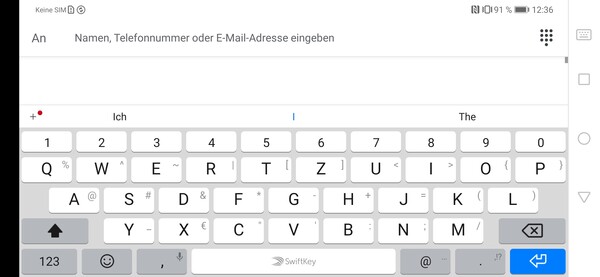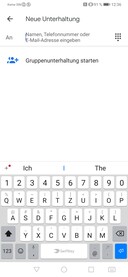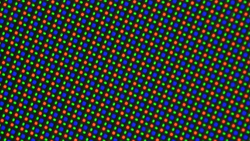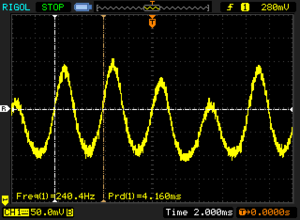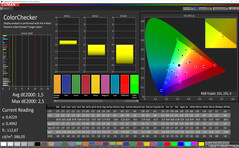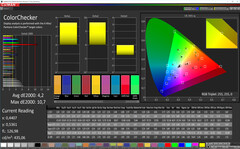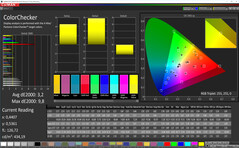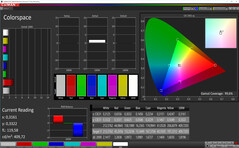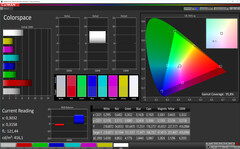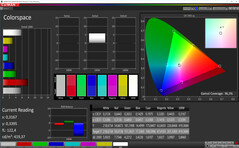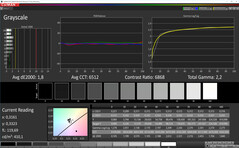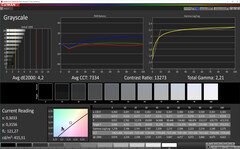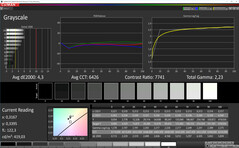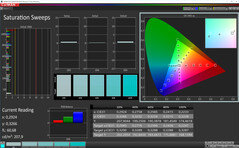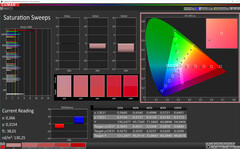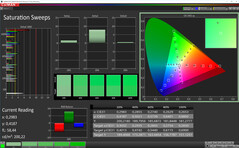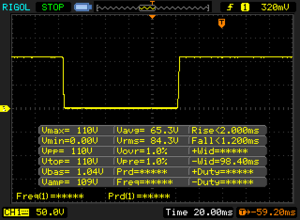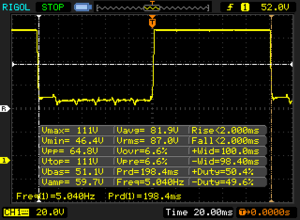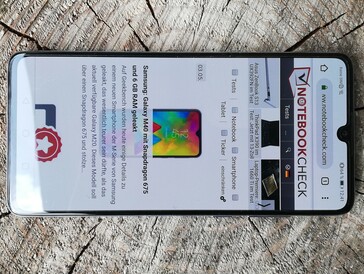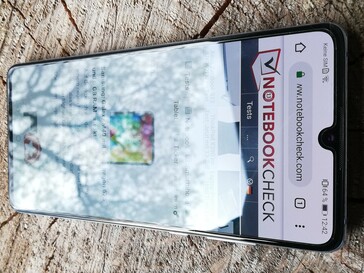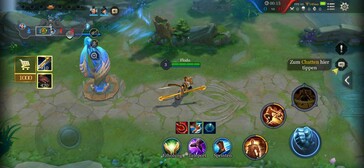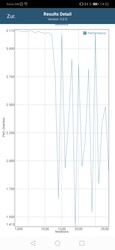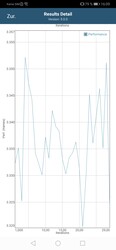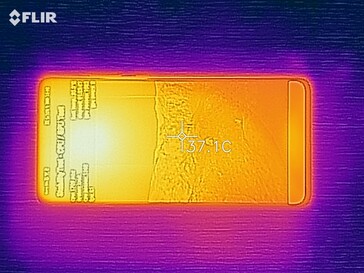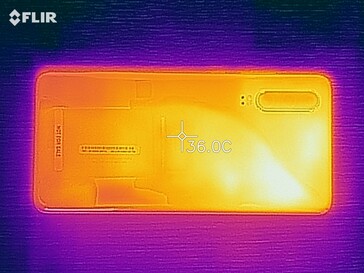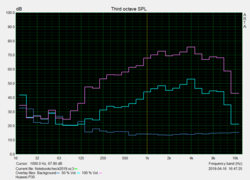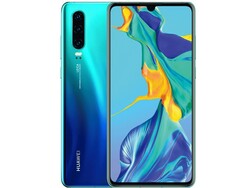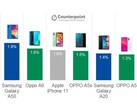Huawei P30 Smartphone Review

After Huawei achieved a good result with its P30 Pro in our testing, now the follow-on to the Huawei P20 is on the bench. Due to its price of around 750 Euro (~$843), the expectations are high. The HiSilicon Kirin 980 coupled with 6 GB of RAM promises good performance though.
With its not ungenerous internal storage capacity of 128 GB and the ARM Mali G76 MP10 GPU should also be capable of handling even more demanding graphical titles with no problems. In addition, this 6.1-inch smartphone is loaded with features such as an under-display fingerprint sensor and a triple camera system with 5x hybrid zoom.
In our testing we evaluate not only the pure system performance of the P30, but also compare it to its competition. In this price segment there are numerous candidates and to most closely match cost and performance we have pitted it against the Samsung Galaxy S10e, Google's Pixel 3, Razer Phone 2, OnePlus 6T and the Xiaomi Mi 9.
Case - The Huawei P30 is Dust & Water-Proof
Huawei has again chosen a frame of metal and a glass rear for the P30. The latter is dominated by its three lenses for the main camera which protrude somewhat more than 1mm out of the housing. A fingerprint sensor is no longer to be found on the rear, as this is now located under the display towards the bottom. The top edge of the P30 features only a hole for the microphone - speakers, USB port and audio jack are located on the bottom of the phone. On the right side you'll find the power button as well as the volume rocker and on the left side the slot for storage and NanoSIM cards.
Our review sample came in the color 'Breathing Crystal', however there are other colors such as black and a color named 'Aurora' which features a gradient between turquoise and blue. The phone is also protected against water and dust ingress with its IP53 rating. According to Huawei though, this protection may reduce with wear.
The P30 features a 6.1 display, which is somewhat larger than its predecessor, however the phone itself has barely changed in terms of dimensions. The newcomer is only half a millimeter wider and is ever so slightly thinner than the Huawei P20. The weight is also unchanged, meaning that the P30 is one of the lightest devices in our comparison lineup.
Features - Android Smartphone with NFC, VoLTE and VoWifi
Huawei has equipped the P30 with a HiSilicon Kirin 980 SoC and an ARM Mali G76 MP10 GPU. This hardware is identical to the Huawei P30 Pro, but whereas the P30 Pro features 8 GB of RAM, the P30 has only 6 GB and 128 GB of storage instead of 256 GB. With this specification, the P30 finds itself in the high-end of smartphones and should not have any issues with more demanding applications and games.
In order to extend storage, users will have to purchase a NanoMemory card, as normal microSD cards are not supported in the P30. By extending the storage you also lose dual-SIM functionality, as SIM slot 2 is a dual function, NanoMemory or SIM slot. Both SIM slots support LTE, VoLTE and VoWifi as long as they are supported/featured by the carrier.
The Huawei phone can be connected to a PC via its USB type-C port which, thanks to its support of the USB 3.1 standard, provides for fast data transfers. A 3.5 mm audio jack is also present for connecting headphones or external speakers.
Software - Android Pie on the P30
Users of the P30 will be greeted with an Android 9 installation. This is combined with Huawei's own EMUI 9.1 UI, which is largely a pure Android experience. Whereas the overall main screen and app overview are very similar compared to other phones, Huawei utilizes a different menu structure for settings. Due to its more detailed descriptions, new users will find themselves quickly at home.
Pre-installed third-party apps such as Facebook and Booking.com can be uninstalled without issue, however Huawei's own apps can only be deactivated. These are mostly involved with system functions - only the App-Gallery informs users of recommended apps and designs which are available for download. The storage of apps on an external storage card, or formatting of said card as internal storage is not possible.
Should the phone be used by more than one person, it's possible to create multiple users. A guest account is also available. With its Widevine L1 support, Full-HD content can also be played back such as on Netflix, Amazon Prime or Maxdome.
Communication & GPS - Fast WLAN on the P30
The Huawei P30 can communicate over the GSM, 3G and LTE networks - the latter featuring category 16 support which results in download rates of up to 1 GBit/s and upload rates of up to 100 MBit/s. Along with NFC and Bluetooth 5.0 the phone features WLAN support for 802.11 a, b, g, n and ac.
With its 2x2 MIMO antenna array, the Huawei P30 achieved 544 Mbps in our testing whilst receiving files, a good but average result compared to the other phones. When transferring files the phone achieved 680 Mbps which puts it at the top of the comparison field. It's important to note though that the P30 supports VHT160 - something our reference router, a Linksys EA8500, does not. It is theoretically possible for the Huawei phone to achieve data transfer rates of up to 1.7 Gbps when paired with a suitable router.
| Networking | |
| iperf3 transmit AX12 | |
| Huawei P30 | |
| Google Pixel 3 | |
| Xiaomi Mi 9 | |
| OnePlus 6T | |
| Samsung Galaxy S10e | |
| Huawei P20 | |
| Razer Phone 2 | |
| Honor View 20 | |
| iperf3 receive AX12 | |
| Xiaomi Mi 9 | |
| Google Pixel 3 | |
| Huawei P20 | |
| OnePlus 6T | |
| Razer Phone 2 | |
| Huawei P30 | |
| Samsung Galaxy S10e | |
| Honor View 20 | |
With the GPS Test app, we test how well the Huawei P30 is able to pinpoint its location. To assist with this, the phone features GPS, A-GPS, Beidou, Galileo GLONASS and QZSS which resulted in us achieving accuracy of up to 4 meters (~13 feet) outdoors. Indoors, we were not able to obtain a satellite signal.
On our customary testing route we pitted the Huawei smartphone against our reference device, a Garmin Edge 500. The plotted course was similarly good and also on longer routes the P30 showed only slight deviations, with curves and sudden changes of direction being somewhat 'rounded-off' compared to the Garmin. The Huawei P30 is therefore a good choice for normal and regular GPS usage.
Phone Function & Voice Quality - Stereo Headset Included
Huawei installs their own app on the P30 for voice calls. This features direct access to a number pad as well as call logs and phonebook via separate tabs. In calls the phone did not have any issues and impressed with good volume and clear voice quality. Background noise was reliably filtered out which resulted in even better call quality. Compared to the P30 Pro, the P30 has a normal earpiece and does not transmit sound through its display.
In very loud environments users can turn to the included stereo headset which allows for even more volume and the possibility to block out more background noise.
Cameras - Triple Camera with Optical Zoom
The Leica triple camera is the highlight of the P30. It consists of a 40 MP sensor with wide-angle lens and f/1.8 aperture, a 16 MP sensor with ultra wide-angle lens and f/2.2 aperture, plus an 8 MP sensor with telephoto objective, f/2.4 aperture and optical image stabilization. The optical zoom is able to work up to a 3x magnification without image quality loss although a steady hand is an advantage here to allow sharp captures. The front camera is a 32 MP unit with a f/2.4 aperture which is especially well suited to portrait photos. This manages even in sub-optimal lighting conditions to create sharp and detailed selfies. Objects in the pictures are well defined and distinct, plus structure and details are reliably reproduced. In the camera app we find multiple AI-assisted manipulation options, such as the adding of effects and color filters, as well as eye enlargement, skin whitening and many more. An HDR mode provides for better color reproduction and when desired, the P30 can be set to capture a photo when it detects a smile.
On an overcast day during our testing, the P30 managed a good panorama shot, in which details were easily visible. In the zoom view, objects are also clearly represented but do suffer somewhat from a loss of sharpness around edges. Color reproduction suffers a little under less than optimal lighting conditions but can still be rated as good. Close-up shots are also managed very well by the Huawei P30. Objects in the picture are sharp and clearly defined, and colors are strong (if a little lighter than they should be). The camera first flexes its muscles however when using its night-mode in low light conditions. The test pattern was clearly defined and colors were also recognizable. Details and fine structure were captured so well that it would be easy to doubt that the light was even turned off. As well as the AI modes, a professional mode is also available which provides for manual tweaking of ambient light, ISO value, white level, shutter speed, focus and brightness. The supermacro mode in our testing was able to capture subpixels on an LCD monitor.
Users of the video function can expect similar picture quality to that of still captures, and AI-modes as well as beauty improvements are also available. Image stabilization means that small vibrations and movements are canceled out and the optical zoom also functions in video mode. The quality of the capture can be adjusted in the settings menu, with the options being 720p, 1080p and 4K UHD. The resolutions 720p and 1080p are also available as HD+ 21:9 format variants and a 60 fps mode allows for high frame rate.
With ColorChecker Passport we check how well the camera of the Huawei P30 reproduces colors. Our results showed that these are reproduced somewhat lighter than expected.
In our controlled lighting environment, the P30 captured our test chart very well. Colors, details and fine structure were well reproduced, although there was some faint washing-out in the lower corners.
Accessories & Guarantee - Huawei P30 with Headset
Included in the box with the Huawei P30 is a USB wall adapter and matching USB type-C cable and a stereo headset. Our review sample also included a silicon case which is not listed in the official package contents and is only available in countries outside Europe. Alongside general accessories such as powerbanks and headsets, Huawei cases and a smart cover are available via various third-party vendors.
Buyers of the P30 receive a 24-month guarantee - if you'd like more information on this subject, please be sure to read our FAQ: Guarantees, Return policies and Warranties.
Input & Usage - Fingerprint Sensor Under the Display
For inputting text the Huawei P30 comes with the keyboard app SwiftKey included. This enables fast and easy typing of messages and can be customized to your individual needs. As well as configurable text size, there are multiple layouts and themes to choose from. The touchscreen was very responsive and accurate, however the pre-installed screen protector did cause some fingertip drag - this made drag and drop operations somewhat difficult which would be especially noticeable in games.
The orientation sensor was reliable and reactive in orienting the screen as appropriate. To unlock the phone, alongside the usual pin and pattern options, users can utilize facial recognition (which also worked well in low light conditions) or the fingerprint sensor which, instead of being located on the rear, is under the lower area of the screen. In the event of a failed attempt to unlock with a fingerprint, the phone will advise the user that they need to press hard on the display. If this advice is followed, the fingerprint sensor functions without issue or delay.
Display - Good Colors & Brightness
Huawei has equipped the P30 with a 6.1-inch OLED display in a 19.5:9 format and 2,340 x 1,080 resolution. The brightness figure of 560 cd/m² as well as backlight uniformity of 95 percent places it in the upper-middle of our comparison field. In the ALP50 test the P30 achieved a luminance score of 673 cd/m² - without its sensor only 412 cd/m² was possible. The lowest configurable brightness was measured at 1.72 cd/m²
Our measuring showed that the P30 suffers from the typical OLED problem of PWM flickering at a frequency of around 250 Hz. As this is very low, it's possible that users with sensitive eyes will have issues over long usage sessions.
| |||||||||||||||||||||||||
Brightness Distribution: 95 %
Center on Battery: 561 cd/m²
Contrast: ∞:1 (Black: 0 cd/m²)
ΔE ColorChecker Calman: 1.5 | ∀{0.5-29.43 Ø4.77}
ΔE Greyscale Calman: 1.8 | ∀{0.09-98 Ø5}
99.6% sRGB (Calman 2D)
Gamma: 2.2
CCT: 6512 K
| Huawei P30 OLED, 2340x1080, 6.1" | Samsung Galaxy S10e AMOLED, 2280x1080, 5.8" | Google Pixel 3 OLED, 2160x1080, 5.5" | Honor View 20 LTPS, 2310x1080, 6.4" | Huawei P20 LTPS, 2240x1080, 5.8" | OnePlus 6T Optic AMOLED, 2340x1080, 6.4" | Xiaomi Mi 9 AMOLED, 2340x1080, 6.4" | Razer Phone 2 IGZO LCD, UltraMotion 120 Hz Display, 2560x1440, 5.7" | |
|---|---|---|---|---|---|---|---|---|
| Screen | -20% | -4% | -46% | 16% | -30% | 15% | -70% | |
| Brightness middle (cd/m²) | 561 | 426 -24% | 393 -30% | 492 -12% | 753 34% | 437 -22% | 593 6% | 600 7% |
| Brightness (cd/m²) | 560 | 427 -24% | 398 -29% | 475 -15% | 748 34% | 442 -21% | 587 5% | 577 3% |
| Brightness Distribution (%) | 95 | 96 1% | 91 -4% | 94 -1% | 96 1% | 95 0% | 94 -1% | 92 -3% |
| Black Level * (cd/m²) | 0.4 | 0.37 | 0.31 | |||||
| Colorchecker dE 2000 * | 1.5 | 2.14 -43% | 1.4 7% | 2.4 -60% | 1.3 13% | 2.21 -47% | 0.9 40% | 3.43 -129% |
| Colorchecker dE 2000 max. * | 2.5 | 3.29 -32% | 2.5 -0% | 5.2 -108% | 2.3 8% | 4.27 -71% | 2 20% | 6.36 -154% |
| Greyscale dE 2000 * | 1.8 | 1.8 -0% | 1.2 33% | 3.2 -78% | 1.7 6% | 2.1 -17% | 1.5 17% | 4.4 -144% |
| Gamma | 2.2 100% | 2.111 104% | 2.19 100% | 2.06 107% | 2.18 101% | 2.307 95% | 2.27 97% | 2.388 92% |
| CCT | 6512 100% | 6329 103% | 6597 99% | 7125 91% | 66.76 9736% | 6353 102% | 6548 99% | 6069 107% |
| Contrast (:1) | 1230 | 2035 | 1935 |
* ... smaller is better
Screen Flickering / PWM (Pulse-Width Modulation)
| Screen flickering / PWM detected | 240.4 Hz | ||
The display backlight flickers at 240.4 Hz (worst case, e.g., utilizing PWM) . The frequency of 240.4 Hz is relatively low, so sensitive users will likely notice flickering and experience eyestrain at the stated brightness setting and below. In comparison: 53 % of all tested devices do not use PWM to dim the display. If PWM was detected, an average of 8084 (minimum: 5 - maximum: 343500) Hz was measured. | |||
A contrast ratio that cannot be measured and black value of 0 cd/m² is also normal for an OLED display. This results in colors well distinguished from one another and black display elements being represented by pixels that are turned off. Users can modify the color temperature of the display either via a free scale option or by choosing one of multiple presets.
Our CalMAN analysis showed that the combination of Normal (colors) and Standard (color temp) in the sRBG color space provided a very balanced color accuracy result. Selecting Vivid (colors) and Standard (color temp) in the P3 color space resulted in somewhat elevated blue levels. If the color temperature in the P3 color space is changed to warm, the blue levels drop and green tones become more dominant.
Display Response Times
| ↔ Response Time Black to White | ||
|---|---|---|
| 3.2 ms ... rise ↗ and fall ↘ combined | ↗ 2 ms rise | |
| ↘ 1.2 ms fall | ||
| The screen shows very fast response rates in our tests and should be very well suited for fast-paced gaming. In comparison, all tested devices range from 0.1 (minimum) to 240 (maximum) ms. » 14 % of all devices are better. This means that the measured response time is better than the average of all tested devices (20.2 ms). | ||
| ↔ Response Time 50% Grey to 80% Grey | ||
| 4 ms ... rise ↗ and fall ↘ combined | ↗ 2 ms rise | |
| ↘ 2 ms fall | ||
| The screen shows very fast response rates in our tests and should be very well suited for fast-paced gaming. In comparison, all tested devices range from 0.165 (minimum) to 636 (maximum) ms. » 14 % of all devices are better. This means that the measured response time is better than the average of all tested devices (31.6 ms). | ||
The OLED display of the P30 is very good in terms of viewing angles and allows for the screen to be viewed from far off to the side without the display becoming distorted, although from extreme angles there is a noticeable green tint which is a characteristic of OLED displays. As long as there are no reflections to create problems, the Huawei phone can be viewed from even inconvenient angles.
Performance - The P30 Delivers Good Results
Huawei has equipped the P30 with the high-end SoC HiSilicon Kirin 980. This features an octa-core CPU clocked up to 2.6 GHz and is paired with 6 GB of RAM, which should provide the P30 with enough grunt to handle more demanding applications without issue. Display duties are handled by an ARM Mali-G76 MP10 GPU which also sits at the upper end of smartphone hardware. The 128 GB of internal storage provides for plenty of space for installation of apps and storage of personal data.
In our benchmarks the Huawei P30 achieved results which place it in the middle of the comparison field. In tests which placed more emphasis on graphical performance, the P30 was frequently placed closer to the bottom. Storage-oriented tests by contrast resulted in the phone dominating most of its competitors. All benchmarks were run with performance mode disabled. When this is active, the P30 achieved, for example, an Overall Score of 4,765 points in Basemark OS II, which is approximately 10 percent higher than standard. In AnTuTu V7, 315,251 was achieved as compared to 290,650 - around 8 percent more.
| AnTuTu v7 - Total Score (sort by value) | |
| Huawei P30 | |
| Samsung Galaxy S10e | |
| Google Pixel 3 | |
| Honor View 20 | |
| Huawei P20 | |
| OnePlus 6T | |
| Xiaomi Mi 9 | |
| Razer Phone 2 | |
| Average HiSilicon Kirin 980 (268359 - 322616, n=10) | |
In our browser benchmarks, the P30 was only able to achieve a place in the middle of the field. The results were however very closely packed together and there would be no issues with everyday use. In ordinary usage, websites were loaded quickly and media was played back promptly. Scrolling and switching between tabs was similarly without issue.
| Jetstream 2 - 2.0 Total Score | |
| Average of class Smartphone (23.8 - 387, n=147, last 2 years) | |
| Honor View 20 (Chrome 74) | |
| Xiaomi Mi 9 (Chrome 73) | |
| Average HiSilicon Kirin 980 (48.4 - 60.9, n=6) | |
| Huawei P30 (Chrome 73) | |
| Speedometer 2.0 - Result 2.0 | |
| Average of class Smartphone (15.2 - 643, n=119, last 2 years) | |
| Honor View 20 (Chrome 74) | |
| Xiaomi Mi 9 (Chrome 73.0.3683.75) | |
| Average HiSilicon Kirin 980 (58.3 - 67.8, n=6) | |
| Huawei P30 (Chrome 73) | |
| WebXPRT 3 - Overall | |
| Average of class Smartphone (38 - 380, n=30, last 2 years) | |
| Xiaomi Mi 9 (Chrome 73.0.3683.75) | |
| Average HiSilicon Kirin 980 (86 - 124, n=10) | |
| Google Pixel 3 (Chrome 70) | |
| Honor View 20 (Chrome 71) | |
| Razer Phone 2 (Chrome 68) | |
| Huawei P30 (Chrome 73) | |
| Huawei P20 | |
| Octane V2 - Total Score | |
| Average of class Smartphone (2228 - 126661, n=194, last 2 years) | |
| Xiaomi Mi 9 (Chrome 73.0.3683.75) | |
| Honor View 20 (Chrome 71) | |
| Average HiSilicon Kirin 980 (20618 - 23285, n=10) | |
| Huawei P30 (Chrome 73) | |
| Samsung Galaxy S10e (Chrome 73) | |
| Razer Phone 2 (Chrome 68) | |
| OnePlus 6T (Chrome 70) | |
| Google Pixel 3 (Chrome 70) | |
| Huawei P20 (Chrome 66.0.3359.126) | |
| Mozilla Kraken 1.1 - Total | |
| Huawei P20 (Chrome 66.0.3359.126) | |
| Google Pixel 3 (Chrome 70) | |
| Razer Phone 2 (Chrome 68) | |
| OnePlus 6T (Chrome 70) | |
| Samsung Galaxy S10e (Chrome 73) | |
| Average HiSilicon Kirin 980 (1948 - 3098, n=10) | |
| Huawei P30 (Chrome 73) | |
| Honor View 20 (Chrome 71) | |
| Xiaomi Mi 9 (Chrome 73.0.3683.75) | |
| Average of class Smartphone (257 - 28190, n=154, last 2 years) | |
| JetStream 1.1 - Total Score | |
| Xiaomi Mi 9 (Chrome 73.0.3683.75) | |
| Honor View 20 (Chrome 71) | |
| Average HiSilicon Kirin 980 (93.2 - 109.9, n=9) | |
| Huawei P30 (Chrome 73) | |
| Razer Phone 2 (Chrome 68) | |
| Google Pixel 3 (Chrome 70) | |
| OnePlus 6T (Chrome 70) | |
| Huawei P20 (Chrome 66.0.3359.126) | |
* ... smaller is better
The internal storage of the P30 is 128 GB in size, of which approximately 110 GB is available for storage of apps and personal data. The read and write rates in our testing were very good and left most of the competition behind.
For expanding storage there is a card slot, however it only supports the NanoMemory card type. With this type of card the Huawei phone also leaves other phones with a storage card slot behind in terms of speed - but the price of entry is high and the performance advantage not that noticeable in practice. The Razer Phone 2 even with its microSD card slot was actually able to achieve faster results than the Huawei P30. Lastly, the expanded storage cannot be formatted as internal storage, and is not available as a storage location for apps.
| Huawei P30 | Samsung Galaxy S10e | Google Pixel 3 | Honor View 20 | Huawei P20 | OnePlus 6T | Xiaomi Mi 9 | Razer Phone 2 | Average 128 GB UFS 2.1 Flash | Average of class Smartphone | |
|---|---|---|---|---|---|---|---|---|---|---|
| AndroBench 3-5 | -21% | -10% | 5% | -4% | -25% | 19% | -20% | -1% | 311% | |
| Sequential Read 256KB (MB/s) | 909 | 792 -13% | 766 -16% | 847 -7% | 827 -9% | 735 -19% | 666 -27% | 733 -19% | 761 ? -16% | 2235 ? 146% |
| Sequential Write 256KB (MB/s) | 186 | 194.1 4% | 181.8 -2% | 250.1 34% | 193.6 4% | 204.4 10% | 388.3 109% | 194.8 5% | 296 ? 59% | 1871 ? 906% |
| Random Read 4KB (MB/s) | 138.8 | 136.9 -1% | 149.8 8% | 168.9 22% | 147 6% | 138.5 0% | 149.4 8% | 124.3 -10% | 154 ? 11% | 297 ? 114% |
| Random Write 4KB (MB/s) | 195.3 | 24.1 -88% | 133.8 -31% | 138.9 -29% | 161.5 -17% | 22 -89% | 165.3 -15% | 23.99 -88% | 130.4 ? -33% | 343 ? 76% |
| Sequential Read 256KB SDCard (MB/s) | 82.8 ? | 73.2 ? -12% | 86.6 ? 5% | 76 ? -8% | ||||||
| Sequential Write 256KB SDCard (MB/s) | 71.3 ? | 60.7 ? -15% | 62.2 ? -13% | 59.6 ? -16% |
Games - No Problem for This Huawei Phone
The ARM Mali-G76 MP10 GPU offers enough performance to be able to fluidly play modern games. We tested with Arena of Valor and PUBG Mobile, both of which on high settings ran smoothly and without issue. The pre-installed display protector though does create some fingertip drag, which makes drag and drop operations more difficult - this would become tiresome over a long play/use period. This problem aside, touch inputs are quickly and without lag translated to the game or application and the orientation sensor is similarly able to input rotation without lag information so that games controlled by this method do not pose any problems.
PUBG Compare
Arena of Valor
Emissions - Speakers for Casual Use
Temperatures
Our measurements showed that the Huawei P30 front reached a maximum of 30 °C (86 °F) at idle and up to 35.5 °C (95.9 °F) under load. In the hand, the phone felt only warm at most warm and never got uncomfortable to hold.
In the demanding GFX Bench ES 2.0 stress test, the phone barely heated up at all and the Huawei phone was able to deliver its full performance over longer time periods without issue. By contrast, the demanding Manhattan 3.1 test brought the P30 to its knees and resulted in significant heat buildup. This test though is an extreme scenario and users of the Huawei P30 can rest assured that it will not have any issues or performance reduction over time due to high temperatures.
(+) The maximum temperature on the upper side is 35.5 °C / 96 F, compared to the average of 35.2 °C / 95 F, ranging from 21.9 to 247 °C for the class Smartphone.
(+) The bottom heats up to a maximum of 33.9 °C / 93 F, compared to the average of 34 °C / 93 F
(+) In idle usage, the average temperature for the upper side is 29.6 °C / 85 F, compared to the device average of 32.9 °C / 91 F.
Speakers
The P30's speaker has good volume with an emphasis on upper-mid tones. Both lower and higher tones are significantly less prominent - added to this, there is significant distortion at maximum volume. For casual playback of media content though, the speaker is well suited. To compliment the main speaker, the earpiece is also used for sound output, but the direction the sound is coming from is clearly the main speaker. The included stereo headset lends itself more towards proper enjoyment of media content.
You can connect your own headphones via the 3.5 mm audio jack. This connector was snug and firm and did not result in any reduction of sound quality. For those who prefer to use Bluetooth 5.0, the phone supports the standards BLE, SBC, AAC, aptX, aptX HD, LDAC and HWA.
Huawei P30 audio analysis
(+) | speakers can play relatively loud (82.4 dB)
Bass 100 - 315 Hz
(-) | nearly no bass - on average 17.5% lower than median
(±) | linearity of bass is average (11.6% delta to prev. frequency)
Mids 400 - 2000 Hz
(±) | higher mids - on average 5.3% higher than median
(+) | mids are linear (5.3% delta to prev. frequency)
Highs 2 - 16 kHz
(±) | higher highs - on average 7.8% higher than median
(+) | highs are linear (5.3% delta to prev. frequency)
Overall 100 - 16.000 Hz
(±) | linearity of overall sound is average (21.5% difference to median)
Compared to same class
» 42% of all tested devices in this class were better, 8% similar, 50% worse
» The best had a delta of 11%, average was 35%, worst was 134%
Compared to all devices tested
» 60% of all tested devices were better, 7% similar, 33% worse
» The best had a delta of 4%, average was 24%, worst was 134%
Samsung Galaxy S10e audio analysis
(+) | speakers can play relatively loud (83 dB)
Bass 100 - 315 Hz
(-) | nearly no bass - on average 69.2% lower than median
(+) | bass is linear (0% delta to prev. frequency)
Mids 400 - 2000 Hz
(-) | nearly no mids - on average 69.2% lower than median
(+) | mids are linear (0% delta to prev. frequency)
Highs 2 - 16 kHz
(-) | nearly no highs - on average 69.2% lower than median
(+) | highs are linear (0% delta to prev. frequency)
Overall 100 - 16.000 Hz
(-) | overall sound is not linear (121.7% difference to median)
Compared to same class
» 90% of all tested devices in this class were better, 8% similar, 2% worse
» The best had a delta of 11%, average was 35%, worst was 134%
Compared to all devices tested
» 97% of all tested devices were better, 2% similar, 1% worse
» The best had a delta of 4%, average was 24%, worst was 134%
Battery Runtime - With Huawei's SuperCharge
Power Consumption
Our measurements showed that the P30 consumed at least 0.69 watts at idle, and a maximum of 6.96 watts under load. This places the Huawei phone among the most power efficient devices in our comparison field - looking at average power consumption, it was able to beat out all other devices.
The included USB power adapter can output a maximum of 22.5 watts and is therefore more than capable of providing the Huawei P30 with enough power for quick charging.
| Off / Standby | |
| Idle | |
| Load |
|
Key:
min: | |
| Huawei P30 3650 mAh | Samsung Galaxy S10e 3100 mAh | Google Pixel 3 2915 mAh | Honor View 20 4000 mAh | Huawei P20 3400 mAh | OnePlus 6T 3700 mAh | Xiaomi Mi 9 3300 mAh | Razer Phone 2 4000 mAh | Average HiSilicon Kirin 980 | Average of class Smartphone | |
|---|---|---|---|---|---|---|---|---|---|---|
| Power Consumption | 4% | -14% | -23% | -8% | 8% | 14% | -23% | -6% | -18% | |
| Idle Minimum * (Watt) | 0.69 | 0.6 13% | 1.21 -75% | 0.97 -41% | 0.67 3% | 0.7 -1% | 0.67 3% | 0.6 13% | 0.802 ? -16% | 0.847 ? -23% |
| Idle Average * (Watt) | 2.41 | 1.2 50% | 2.01 17% | 2.58 -7% | 2.05 15% | 1.1 54% | 1.26 48% | 1.5 38% | 2.07 ? 14% | 1.448 ? 40% |
| Idle Maximum * (Watt) | 2.51 | 1.5 40% | 2.05 18% | 2.63 -5% | 2.11 16% | 2.1 16% | 1.29 49% | 2.6 -4% | 2.38 ? 5% | 1.633 ? 35% |
| Load Average * (Watt) | 3.86 | 5.2 -35% | 4.06 -5% | 5.24 -36% | 6.15 -59% | 4.2 -9% | 3.71 4% | 7.2 -87% | 4.87 ? -26% | 6.96 ? -80% |
| Load Maximum * (Watt) | 6.96 | 10.2 -47% | 8.79 -26% | 8.73 -25% | 8.09 -16% | 8.3 -19% | 9.3 -34% | 12.3 -77% | 7.46 ? -7% | 11.3 ? -62% |
* ... smaller is better
Battery Runtime
In our real-world WLAN testing, the Huawei P30 achieved almost 12 hours of Internet browsing until it needed to be connected up to the charger - not bad, however only average when compared to the rest of the field. Its predecessor for example was able to achieve almost 100 minutes longer, meaning that it was able to play back longer video content.
The included charger supports Huawei's SuperCharge technology and charges the 3,650 mAh battery up to full capacity in a little over one and a half hours.
| Huawei P30 3650 mAh | Samsung Galaxy S10e 3100 mAh | Google Pixel 3 2915 mAh | Honor View 20 4000 mAh | Huawei P20 3400 mAh | OnePlus 6T 3700 mAh | Xiaomi Mi 9 3300 mAh | Razer Phone 2 4000 mAh | |
|---|---|---|---|---|---|---|---|---|
| Battery runtime | -32% | -29% | 8% | 8% | 9% | -13% | -18% | |
| Reader / Idle (h) | 31.9 | 19.8 -38% | 22.9 -28% | 32.1 1% | 31.5 -1% | 32.3 1% | 27.5 -14% | 27.2 -15% |
| H.264 (h) | 17.5 | 13.3 -24% | 12.1 -31% | 15.5 -11% | 13.5 -23% | 15.1 -14% | 16.8 -4% | 12.4 -29% |
| WiFi v1.3 (h) | 11.9 | 6.9 -42% | 7.9 -34% | 16.2 36% | 13.6 14% | 14.4 21% | 9.1 -24% | 8.9 -25% |
| Load (h) | 3.5 | 2.7 -23% | 2.7 -23% | 3.7 6% | 4.9 40% | 4.4 26% | 3.2 -9% | 3.4 -3% |
Pros
Cons
Verdict - Great Phone with a Few Drawbacks
The Huawei P30 impresses not only with its slim design, but also with its very good camera. What impressed us in particular was its capture performance in low-light situations and its super-macro function. Performance was as expected very high, but it managed only a place in the middle of the pack. Our impressions of the display were mixed - colors and brightness/contrast were very good, however there was noticeable PWM flickering which would be a problem for those with sensitive eyes.
The Huawei P30 justifies its price, but purchasers will have to leave with some minor drawbacks.
The not-particularly-impressive battery performance in WLAN usage also hurts it somewhat, however the fast-charger only requires 1 1/2 hours to fully recharge the device. Huawei's P30 only has minor issues and the high price is justified. With its under-display fingerprint sensor, OLED display and 3x optical zoom, buyers will no doubt find using this phone enjoyable.
Huawei P30
- 09/03/2022 v7 (old)
Mike Wobker




